Allanite in Variscan Post-Collisional Lamprophyre Dykes from Les Guilleries (NE Iberia) as a Part of Rare Earth Elements Recycling in Collisional Orogens
Abstract
:1. Introduction
2. Geological Setting
3. Materials and Methods
4. Results
4.1. Petrography
4.2. Microprobe Chemistry
4.3. Principal Component Analyses
4.4. LA-ICP-MS In Situ U-Th-Pb Ages
5. Discussion
6. Conclusions
Supplementary Materials
Author Contributions
Funding
Data Availability Statement
Conflicts of Interest
References
- Owen, J.P. Geochemistry of lamprophyres from the Western Alps, Italy: Implications for the origin of an enriched isotopic component in the Italian mantle. Contrib. Mineral. Petrol. 2008, 155, 341–362. [Google Scholar] [CrossRef]
- Seifert, T. Metallogeny and Petrogenesis of Lamprophyres in the Mid-European Variscides; IOS Press: Amsterdam, The Netherlands, 2008. [Google Scholar]
- Soder, C. Geochemistry and Petrology of Lamprophyres from the Hellenides and the European Variscides. Ph.D. Thesis, University of Heidelberg, Heidelberg, Germany, 2017. [Google Scholar]
- Errandonea-Martin, J.; Sarrionandia, F.; Carracedo-Sánchez, M.; Gil Ibarguchi, J.I.; Eguíluz, L. Petrography and geochemistry of late- to post-Variscan vaugnerite series rocks and calc-alkaline lamprophyres within a cordierite-bearing monzogranite (the Sierra Bermeja Pluton, southern Iberian Massif). Geol. Acta 2018, 16, 237–255. [Google Scholar]
- Le Maitre, R.; Streckeisen, A.; Zanettin, B.; Le Bas, M.; Bonin, B.; Bateman, P. (Eds.) Igneous Rocks: A Classification and Glossary of Terms: Recommendations of the International Union of Geological Sciences Subcommission on the Systematics of Igneous Rocks, 2nd ed.; Cambridge University Press: Cambridge, UK, 2002. [Google Scholar]
- Mellado, E.; Corbella, M.; Navarro-Ciurana, D.; Kylander-Clark, A. The enriched Variscan lithosphere of NE Iberia: Data from post-collisional Permian calc-alkaline lamprophyre dykes of Les Guilleries. Geol. Acta 2021, 19, 1–23. [Google Scholar] [CrossRef]
- Deer, W.A.; Howie, R.A.; Zussman, J. Rock-Forming Minerals, Vol. 1B: Disilicates and Ringsilicates, 2nd ed.; Longman: Harlow, UK, 1986. [Google Scholar]
- Gieré, R.; Sorensen, S.S. Allanite and other REE-rich epidote group minerals. Rev. Mineral. Geochem. 2004, 56, 431–493. [Google Scholar] [CrossRef]
- Armbruster, T.; Bonazzi, P.; Akasaka, M.; Bermanec, V.; Chopin, C.; Giere, R.; Heuss-Assbichler, S.; Liebscher, A.; Menchetti, S.; Pan, Y. Recommended nomenclature of epidote-group minerals. Eur. J. Mineral. 2006, 18, 551–567. [Google Scholar] [CrossRef] [Green Version]
- Catlos, E.J.; Sorensen, S.S.; Harrison, T.M. Th–Pb ion-microprobe dating of allanite. Am. Mineral. 2000, 85, 633–648. [Google Scholar] [CrossRef]
- Grapes, R.H.; Hoskin, W.O. Epidote group minerals in low-medium pressure metamorphic terranes. Rev. Mineral. Geochem. 2004, 56, 301–345. [Google Scholar] [CrossRef]
- Finger, F.; Broska, I.; Roberts, M.P.; Schermaier, A. Replacement of primary monazite by apatite-allanite-epidote coronas in amphibolite facies granite gneiss from the eastern Alps. Am. Mineral. 1998, 83, 248–258. [Google Scholar] [CrossRef]
- Janots, E.; Engi, M.; Berger, A.; Allaz, J.; Schwarz, J.O.; Spandler, C. Prograde metamorphic sequence of REE minerals in pelitic rocks of the Central Alps: Implications for allanite–monazite–xenotime phase relations from 250 to 610 °C. J. Metamorph. Geol. 2008, 26, 509–526. [Google Scholar] [CrossRef]
- Janots, E.; Berger, A.; Engi, M. Physico-chemical control on the REE-mineralogy in chloritoid-grade metasediments from a single outcrop (Central Alps, Switzerland). Lithos 2011, 121, 1–11. [Google Scholar] [CrossRef]
- Engi, M. Petrochronology based on REE-minerals: Monazite, allanite, xenotime, apatite. Rev. Mineral. Geochem. 2017, 83, 365–418. [Google Scholar] [CrossRef]
- Goswami-Banerjee, S.; Robyr, M. Pressure and temperature conditions for crystallization of metamorphic allanite and monazite in metapelites: A case study from the Miyar Valley (high Himalayan Crystalline of Zanskar, NW India). J. Metamorph. Geol. 2015, 33, 535–556. [Google Scholar] [CrossRef]
- Budzyń, B.; Harlov, D.; Williams, M.; Jercinovic, M. Experimental determination of stability relations between monazite, fluorapatite, allanite, and REE-epidote as a function of pressure, temperature, and fluid composition. Am. Mineral. 2011, 96, 1547–1567. [Google Scholar] [CrossRef]
- Cenki-Tok, B.; Darling, J.; Rolland, Y.; Rossi, M.; Engi, M. Allanite Behavior in Upper-Mid Crustal Shear Zones: Can we Date Deformation Directly? Example from the Mont Blanc Massif and Implications on Its Alpine Evolution. Terra Nova 2011, 0, 1–9. [Google Scholar]
- Levinson, A.A. A system of nomenclature for rare-earth minerals. Am. Mineral. 1966, 51, 152–158. [Google Scholar]
- Beard, J.; Sorensen, S.; Gieré, R. REE zoning in allanite related to changing partition coefficients during crystallization: Implications for REE behaviour in an epidote-bearing tonalite. Miner. Mag. 2006, 70, 419–436. [Google Scholar] [CrossRef] [Green Version]
- Klimm, K.; Blundy, J.D.; Green, T.H. Trace Element Partitioning and Accessory Phase Saturation during H2O-Saturated Melting of Basalt with Implications for Subduction Zone Chemical Fluxes. J. Petrol. 2008, 49, 523–553. [Google Scholar] [CrossRef] [Green Version]
- Hermann, J. Allanite: Thorium and light rare earth element carrier in subducted crust. Chem. Geol. 2002, 192, 289–306. [Google Scholar] [CrossRef]
- Smye, A.; Roberts, N.; Condon, D.; Horstwood, M.; Parrish, R. Characterising the U-Th-Pb systematics of allanite by ID and LA-ICPMS: Implications for geochronology. Geochim. Cosmochim. Acta 2014, 135, 1–28. [Google Scholar] [CrossRef]
- Oberli, F.; Meier, M.; Berger, A.; Rosenberg, C.; Gieré, R. U-Th-Pb and 230Th/238U disequilibrium isotope systematics: Precise accessory mineral chronology and melt evolution tracing in the Alpine Bergell intrusion. Geochim. Cosmochim. Acta 2004, 68, 2543–2560. [Google Scholar] [CrossRef]
- Gregory, C.J.; Rubatto, D.; Hermann, J.; Berger, A.; Engi, M. Allanite behaviour during incipient melting in the southern Central Alps. Geochim. Cosmochim. Acta 2012, 84, 433–458. [Google Scholar] [CrossRef]
- Janots, E.; Rubatto, D. U–Th–Pb dating of collision in the external Alpine domains (Urseren zone, Switzerland) using low temperature allanite and monazite. Lithos 2014, 184–187, 155–166. [Google Scholar] [CrossRef]
- Reche, J.; Martínez, F.J. Evolution of bulk composition, mineralogy, strain style and fluid flow during an HT-LP metamorphic event: Sillimanite zone of the Catalan Coastal Ranges, Variscan basement, NE Iberia. Tectonophysics 2002, 348, 111–134. [Google Scholar] [CrossRef]
- Arche, A.; López-Gómez, J. Origin of the Permian-Triassic Iberian Basin, central-eastern Spain. Tectonophysics 1996, 266, 443–464. [Google Scholar] [CrossRef]
- Perini, G.; Cebria, J.M.; Lopez-Ruiz, J.; Doblas, M. Carboniferous-Permian mafic magmatism in the Variscan belt of Spain and France: Implications for mantle sources. Geol. Soc. Spec. Publ. 2004, 223, 415–438. [Google Scholar] [CrossRef]
- Liesa, M.; Aguilar, C.; Castro, A.; Gisbert, G.; Reche, J.; Muñoz, J.A.; Vilà, M. The role of mantle and crust in the generation of calc-alkaline Variscan magmatism and its tectonic setting in the Eastern Pyrenees. Lithos 2021, 406–407, 106541. [Google Scholar] [CrossRef]
- Enrique, P. The Hercynian intrusive rocks of the Catalonian Coastal Ranges (NE Spain). Acta Geol. Hisp. 1990, 25, 39–64. [Google Scholar]
- Esteve, S.; Sunyer, J.; Culí, L.; Cirés, J.; Alías, G. El complejo intrusivo diorítico-gabroico de Susqueda (Macizo del Montseny-Guilleries, Cataluña): Unidades litológicas y características petrográficas. Geogaceta 2016, 60, 99–102. [Google Scholar]
- Martínez, F.J.; Reche, J.; Iriondo, A. U-Pb SHRIMP-RG zircon ages of Variscan igneous rocks from the Guilleries massif (NE Iberia pre-Mesozoic basement): Geological implications. C. R. Geosci. 2008, 340, 223–232. [Google Scholar] [CrossRef]
- Esteve, S.; Enrique, P.; Alías, G. Relaciones intrusivas y cronología relativa del plutón básico de Susqueda con las rocas metamórficas encajantes (Cordillera Prelitoral Catalana). Geogaceta 2018, 63, 107–110. [Google Scholar]
- Martínez, F.J.; Universitat Autònoma de Barcelona, Barcelona, Spain. Personal communication, 2022.
- Solé, J.; Cosca, M.; Sharp, Z.; Enrique, P. 40Ar/39Ar Geochronology and stable isotope geochemistry of Late-Hercynian intrusions from north-eastern Iberia with implications for argon loss in K-feldspar. Int. J. Earth. Sci. 2002, 91, 865–881. [Google Scholar]
- Butjosa, L.; Enrique, P.; Galán, G. Las hornblenditas, gabros y dioritas del Macizo del Montnegre (Barcelona, Cordilleras Costero Catalanas). Geogaceta 2013, 54, 35–38. [Google Scholar]
- Galán, G.; Enrique, P.; Butjosa, L.; Fernández-Roig, M. Spinels of Variscan olivine hornblendites related to the Montnegre granitoids revisited (NE Spain): Petrogenetic evidence of mafic magma mixing. Geol. Acta 2017, 15, 323–336. [Google Scholar]
- Saxena, S.K.; Walter, L.S. A statistical-chemical and thermodynamic approach to the study of lunar mineralogy. Geochim. Cosmochim. Acta 1974, 38, 79–95. [Google Scholar] [CrossRef]
- Ubide, T.; Gale, C.; Larrea, P.; Arranz Yagüe, E.; Lago San José, M.; Tierz, P. The Relevance of Crystal Transfer to Magma Mixing: A Case Study in Composite Dykes from the Central Pyrenees. J. Petrol. 2014, 55, 1535–1559. [Google Scholar] [CrossRef] [Green Version]
- Iwamori, H.; Albarède, F. Decoupled isotopic record of ridge and subduction zone processes in oceanic basalts by independent component analysis. Geochem. Geophys. Geosyst. 2008, 9, 1525–2027. [Google Scholar] [CrossRef]
- Spencer, K.; Hacker, B.; Kylander-Clark, A.; Andersen, T.; Cottle, J.; Stearns, M.; Poletti, J.; Seward, G. Campaign-style titanite U-Pb dating by laser-ablation ICP: Implications for crustal flow, phase transformations and titanite closure. Chem. Geol. 2013, 341, 84–101. [Google Scholar] [CrossRef]
- Kylander-Clark, A.; Hacker, B.; Cottle, J. Laser-ablation split-stream ICP petrochronology. Chem. Geol. 2013, 345, 99–112. [Google Scholar] [CrossRef]
- Kylander-Clark, A. Expanding Limits of Laser-Ablation U-Pb Calcite Geochronology. Geochronology 2020, 2, 343–354. [Google Scholar] [CrossRef]
- von Blackenburg, F. Combined high-precision chronometry and geochemical tracing using accessory minerals: Applied to the Central-Alpine Bergell intrusion (central Europe). Chem. Geol. 1992, 100, 19–40. [Google Scholar] [CrossRef]
- Petrík, I.; Broska, I.; Lipka, J.; Siman, P. Granitoid Allanite-(Ce) sub-stitution relations, redox conditions and REE distributions (on an Example of I-Type Granitoids, Western Carpathians, Slovakia). Geol. Carpath. 1995, 46, 79–94. [Google Scholar]
- Broska, I.; Petrík, I. Accessory Phases in the Genesis of Igneous Rocks. In Modelling of Magmatic and Allied Processes; Kumar, S., Singh, R., Eds.; Society of Earth Scientists Series; Springer: Cham, Switzerland, 2014. [Google Scholar]
- Vlach, S.R.F.; Gualda, G.A.R. Allanite and chevkinite in A-type granites and syenites of the Graciosa Province, southern Brazil. Lithos 2007, 97, 98–121. [Google Scholar] [CrossRef]
- Hirtopanu, P.; Andersen, J.; Fairhurst, R.J.; Jakab, G. Allanite-(ce) and its associations, from the Ditrau alkaline intrusive massif, East Carpathians, Romania. Proc. Rom. Acad. Series B 2013, 15, 59–74. [Google Scholar]
- Schulmann, K.; Catalán, J.R.; Lardeaux, J.; Janousek, V.; Oggiano, G. The Variscan orogeny: Extent, timescale and the formation of the European crust. In book: The Variscan Orogeny: Extent, Timescale and the Formation of the European Crust. Geol. Soc. Spec. Publ. 2014, 405, 1–6. [Google Scholar] [CrossRef]
- Sun, S.S.; McDonough, W.F. Chemical and isotopic systematics of oceanic basalts implications for mantle composition and processes. In Magmatism in the Ocean Basins; Saunders, A.D., Norry, M.J., Eds.; Geological Society of London: London, UK, 1989; pp. 313–345. [Google Scholar]
- Navidad, M.; Castiñeiras, P.; Casas, J.M.; Liesa, M.; Fernández-Suárez, J.; Barnolas, A.; Carreras, J.; Gil-Peña, I. Geochemical characterization and isotopic age of Caradocian magmatism in the northeastern Iberian Peninsula: Insights into the Late Ordovician evolution of the northern Gondwana margin. Gondwana Res. 2010, 17, 325–337. [Google Scholar] [CrossRef] [Green Version]
- Dijkstra, A.H.; Hatch, C. Mapping a hidden terrane boundary in the mantle lithosphere with lamprophyres. Nat. Commun. 2018, 9, 3770. [Google Scholar] [CrossRef]
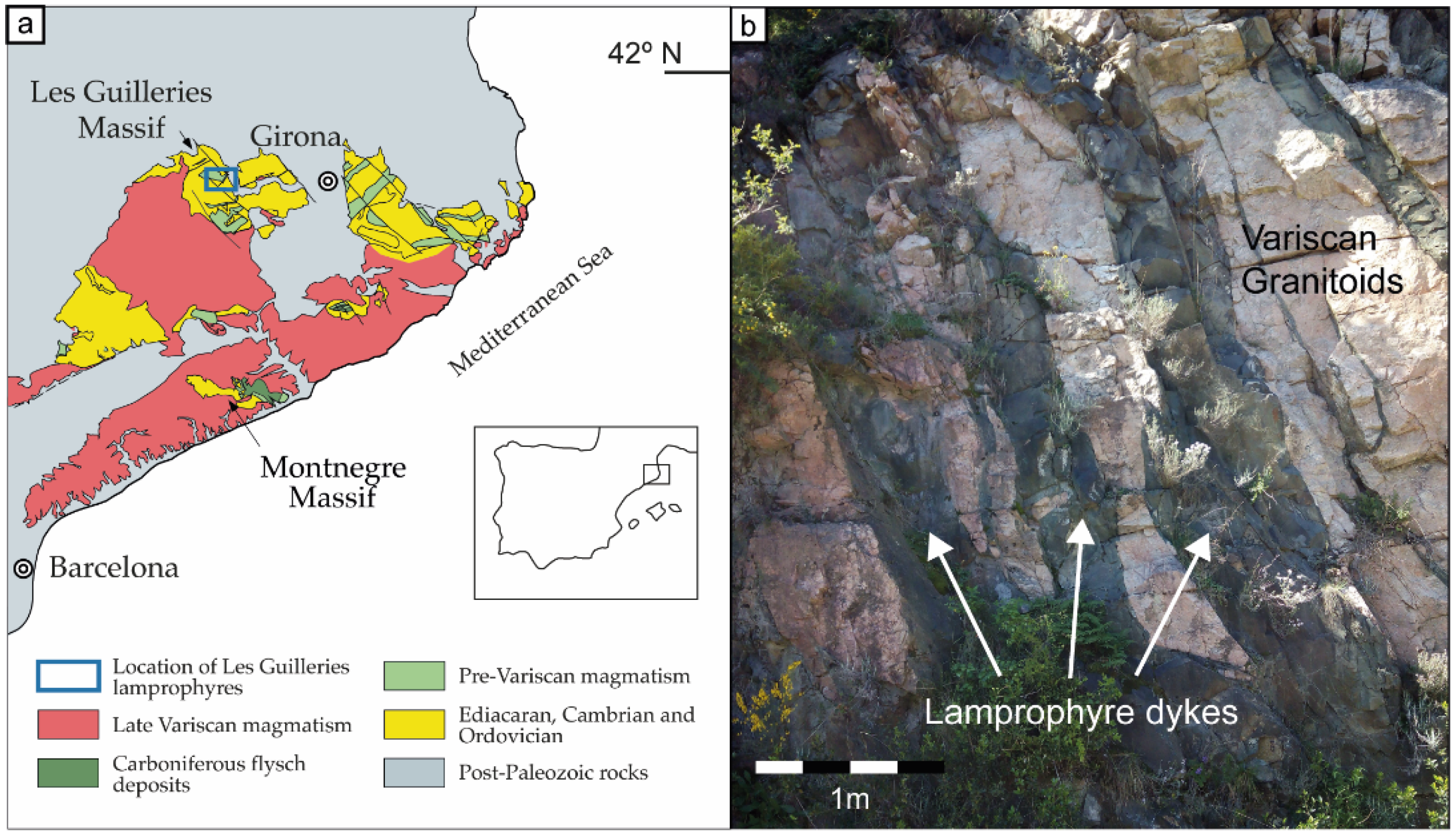
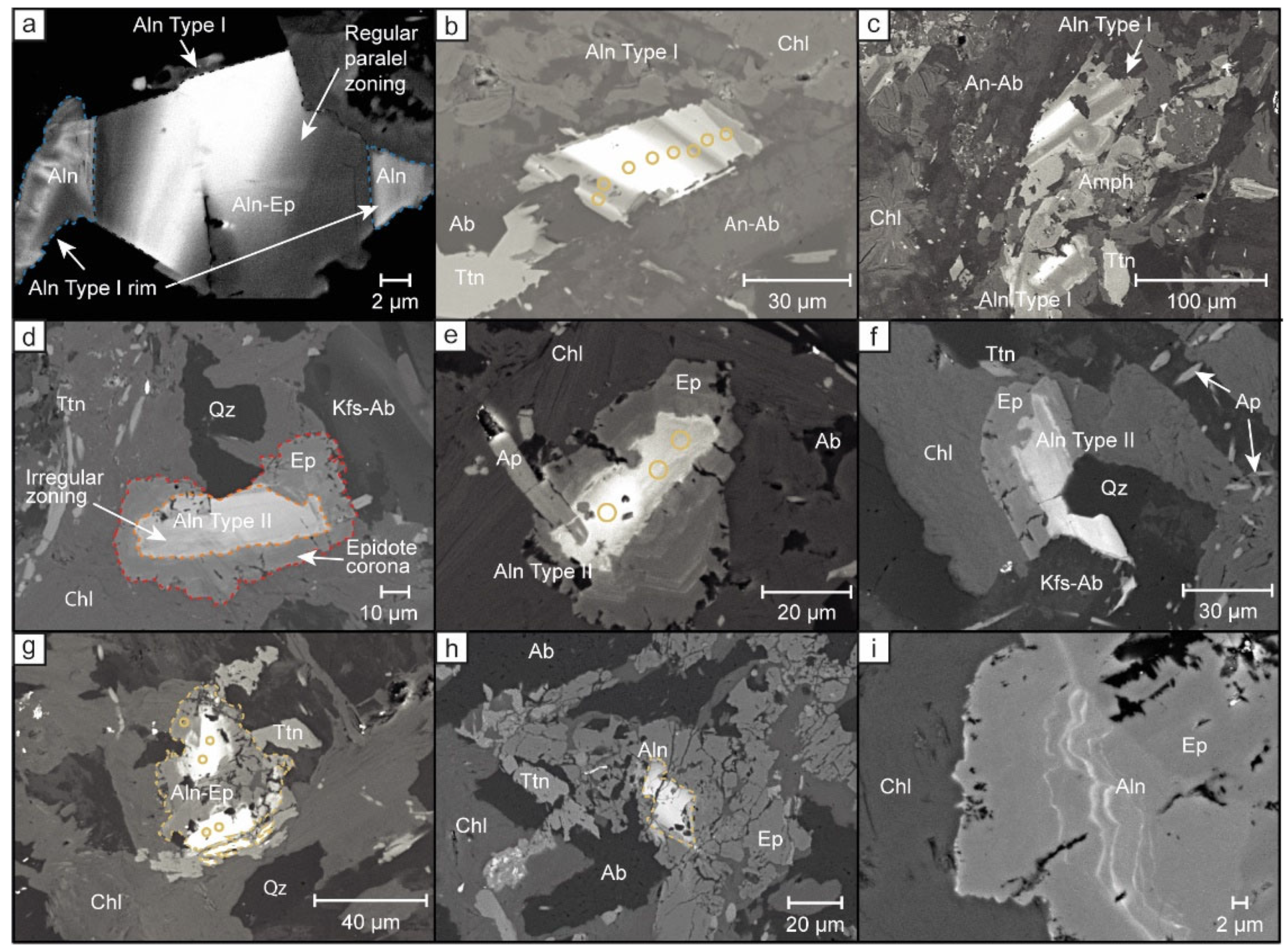
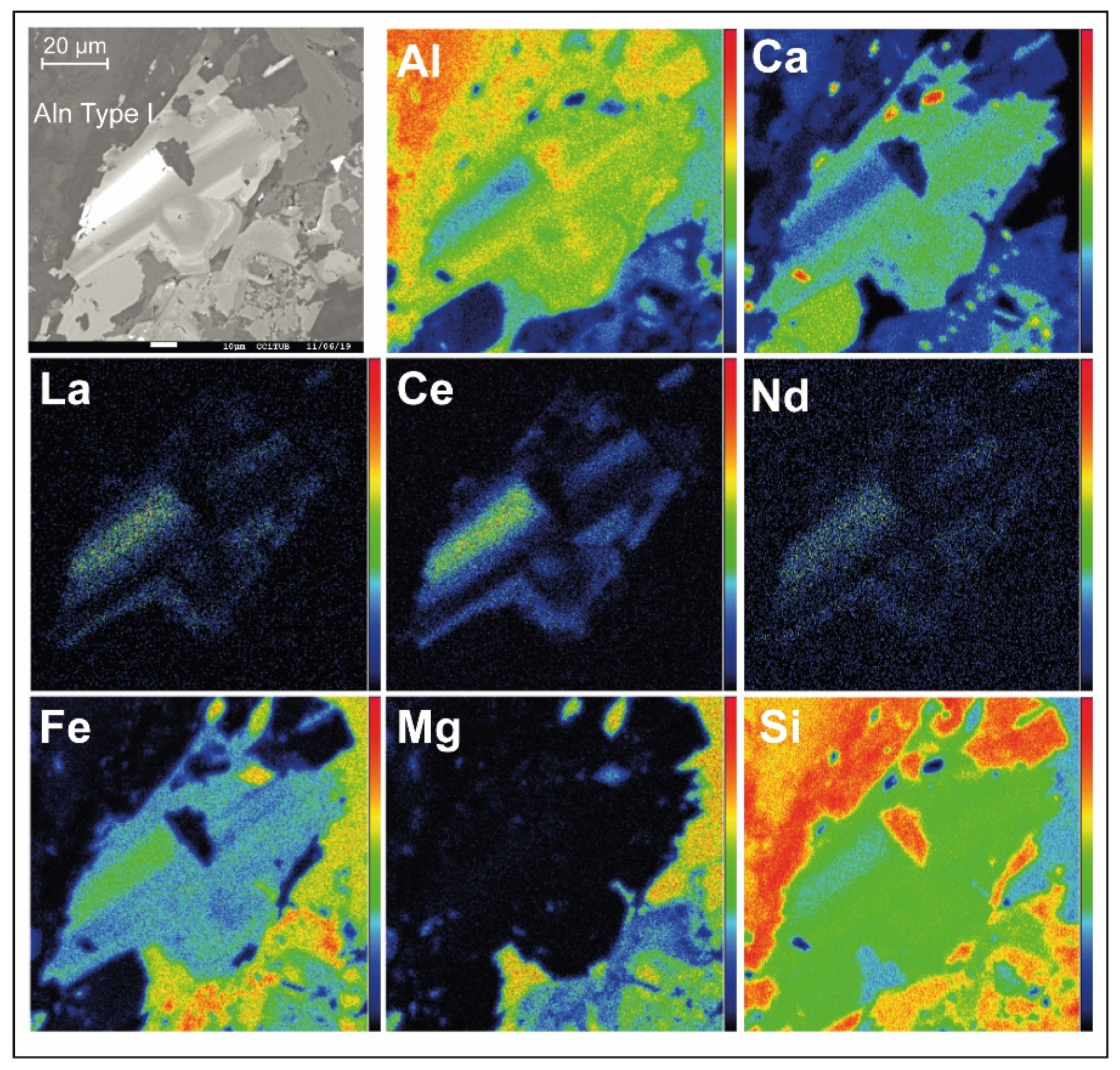
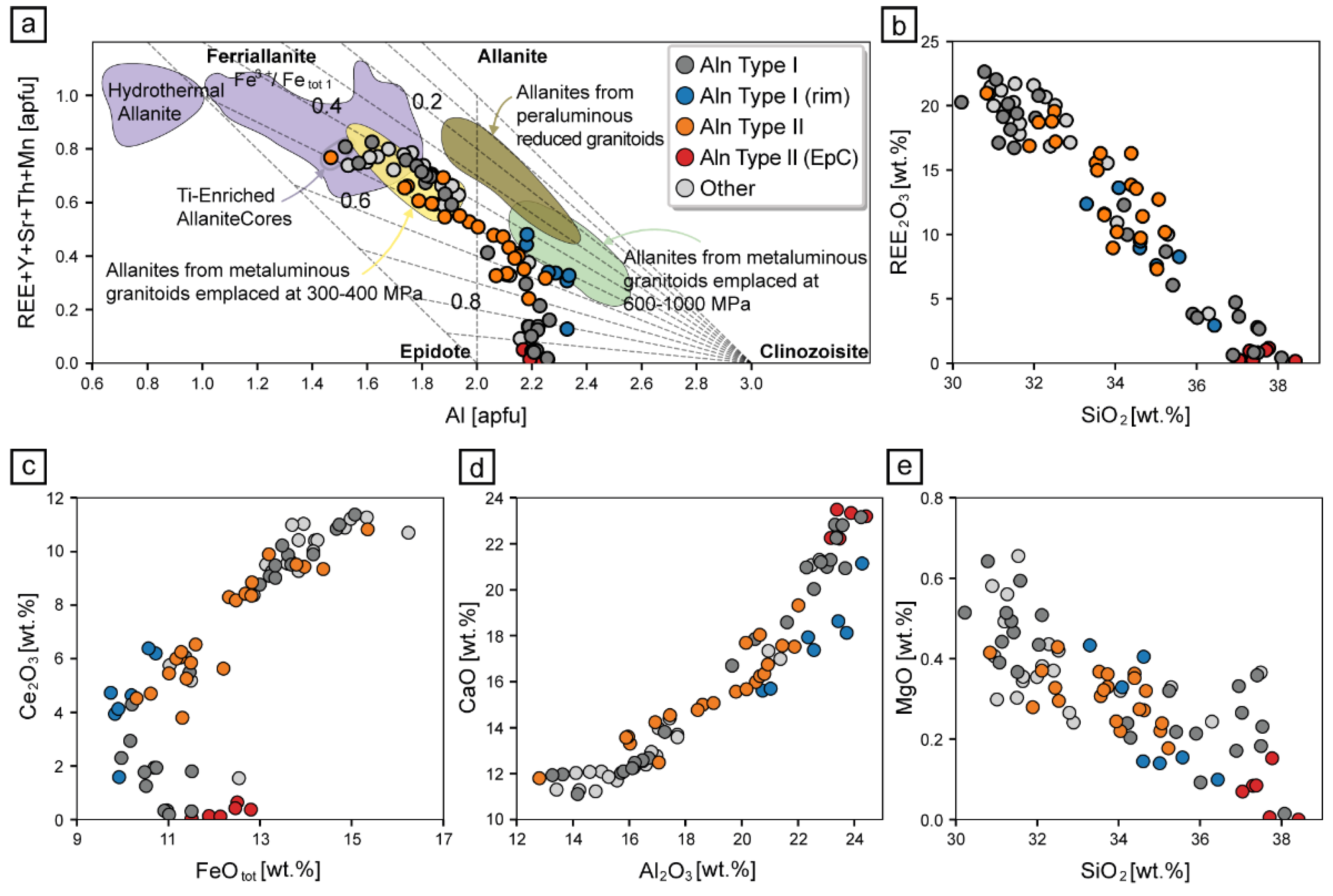
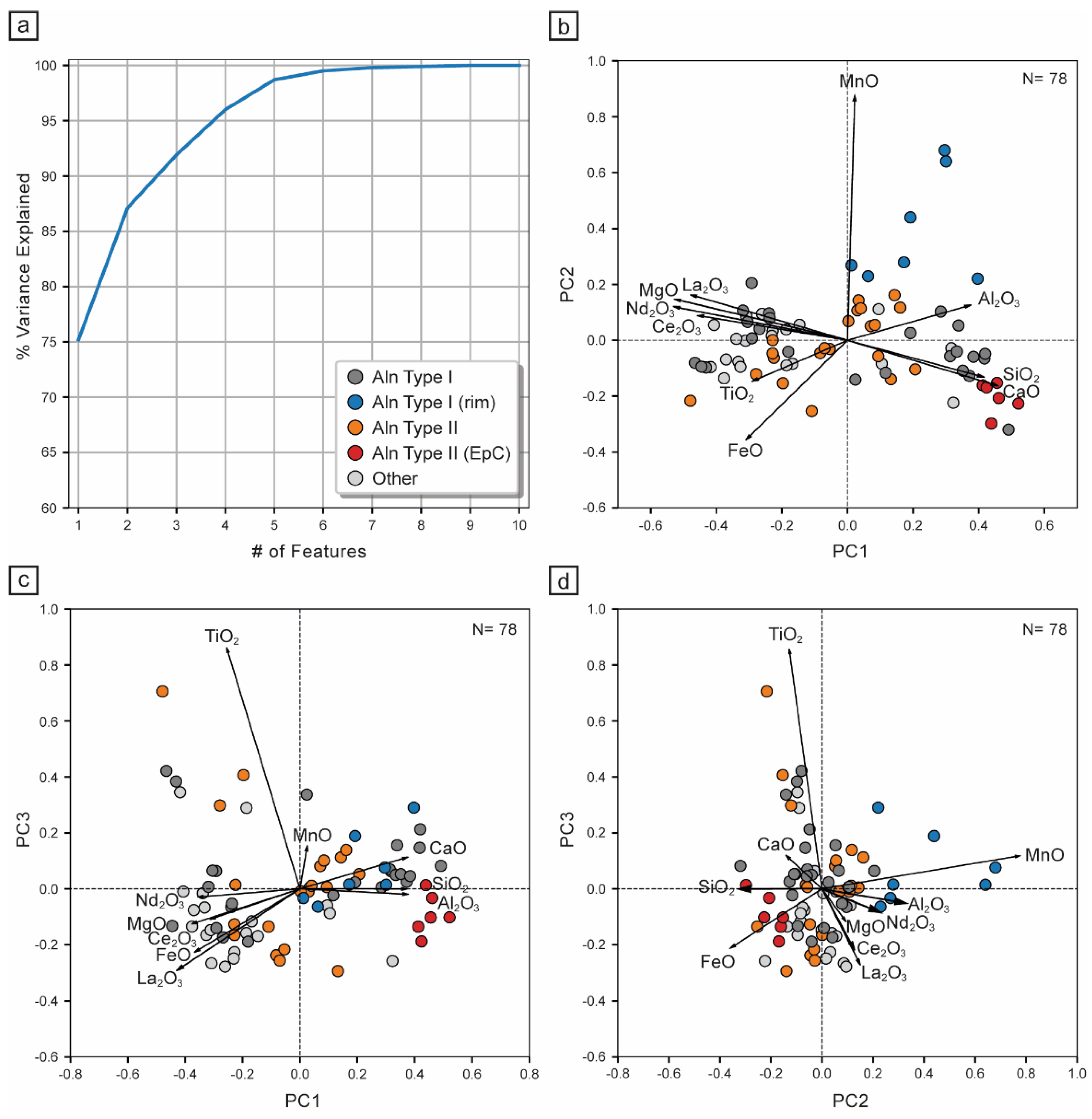
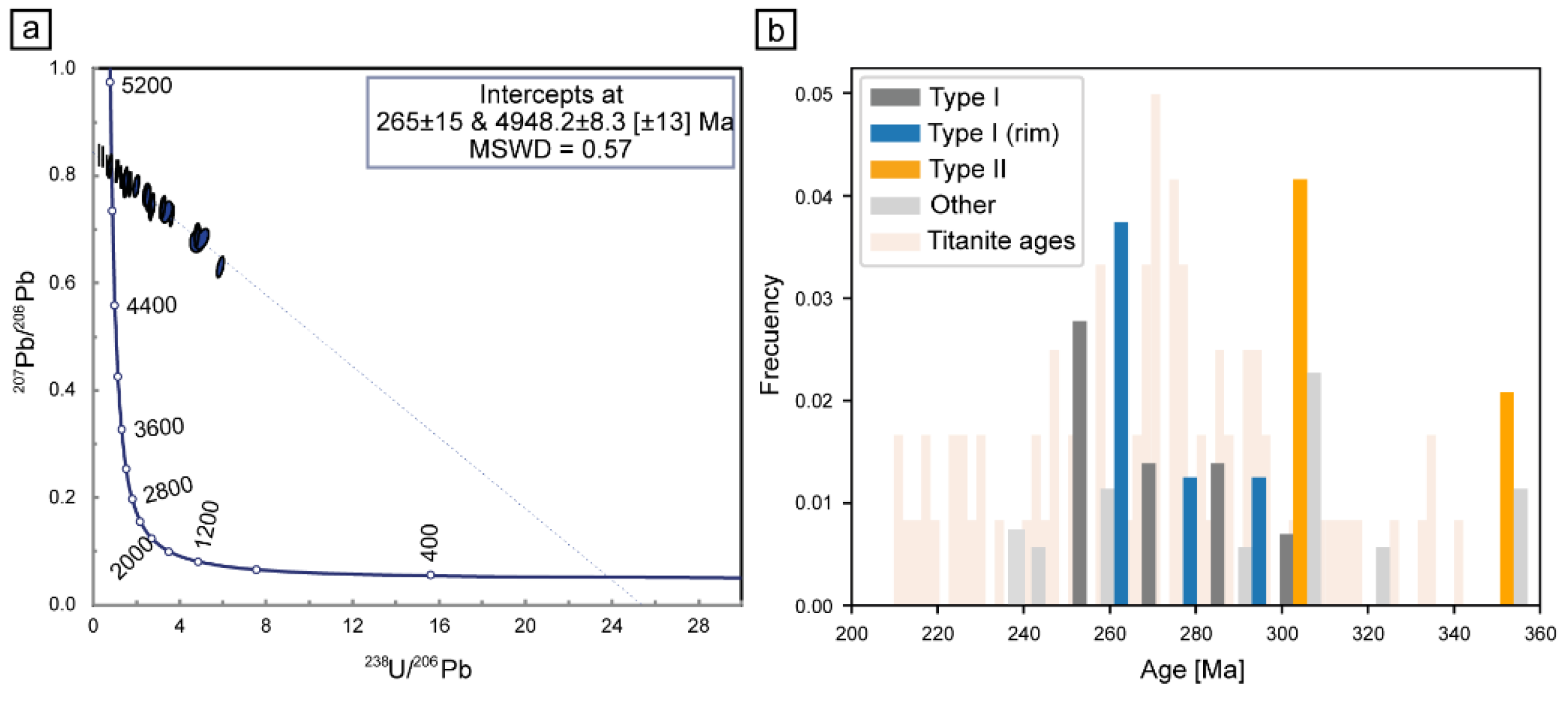
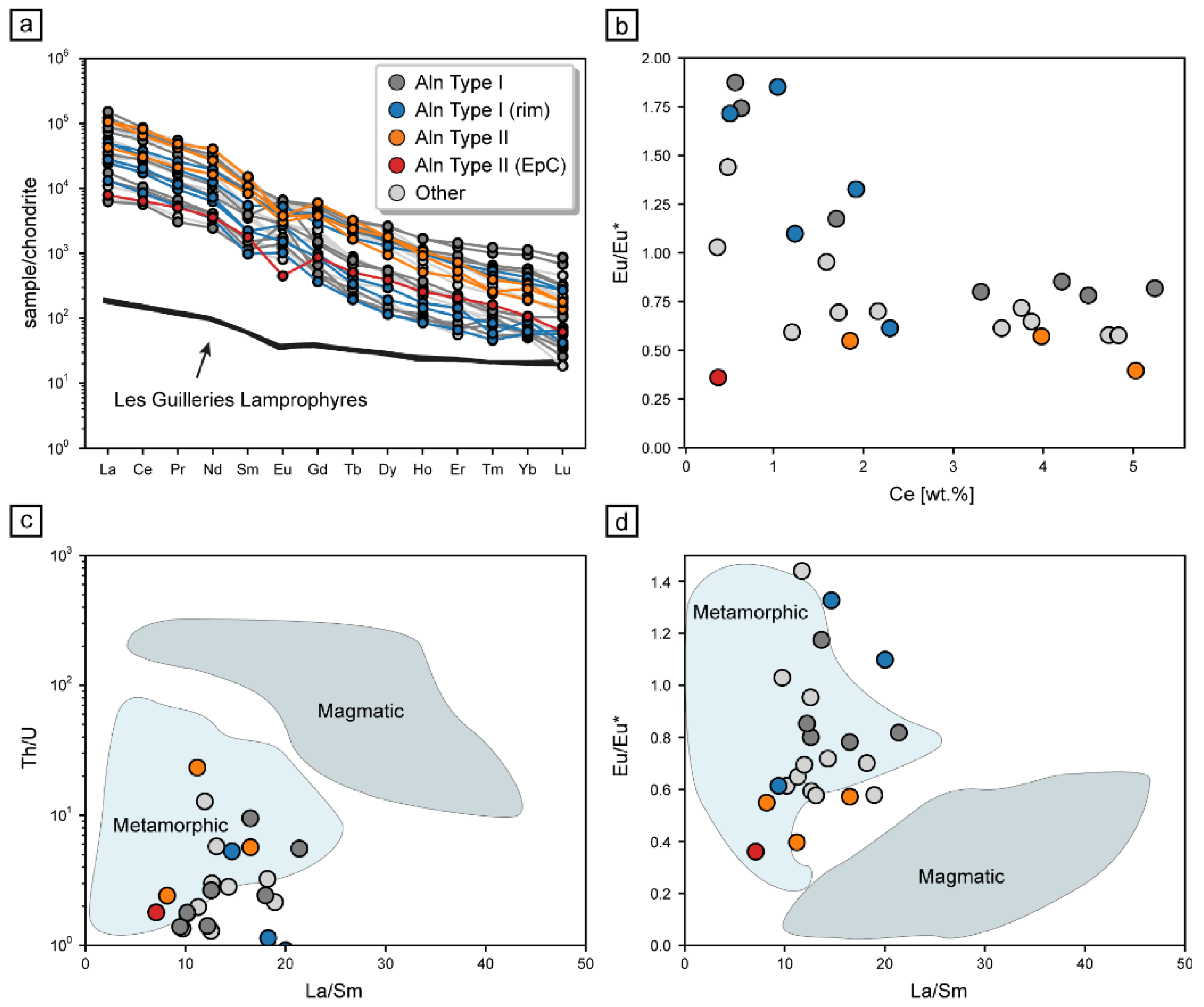
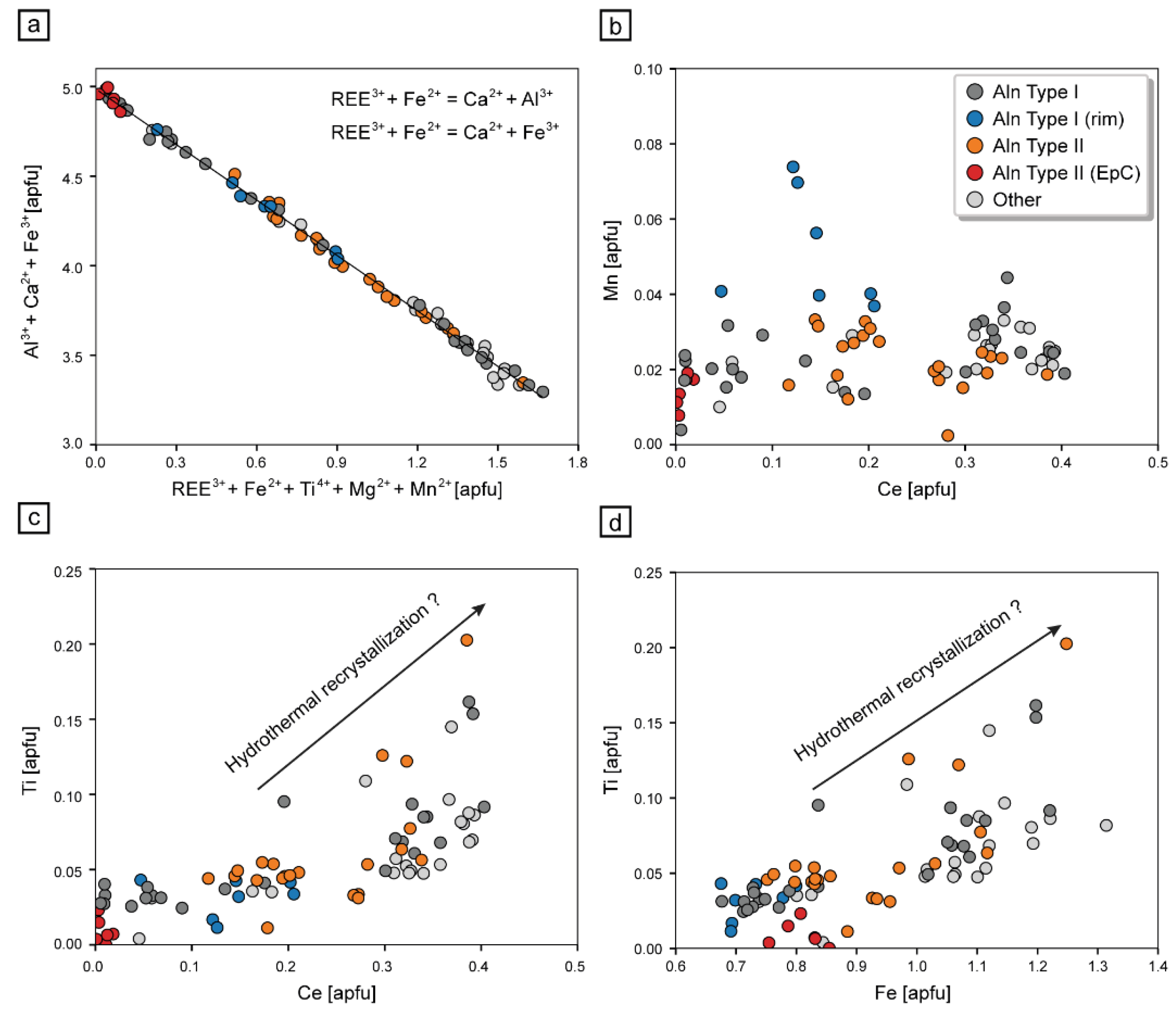
| Allanite Type | Type I | Type I (rim) | Type II | Type II (EpC) | Other |
|---|---|---|---|---|---|
| Nº of Analyses | 24 | 7 | 21 | 6 | 20 |
| SiO2 | 30.2–38.1 | 33.3–36.4 | 30.8–35.2 | 37.0–38.4 | 30.9–37.5 |
| Al2O3 | 13.3–24.2 | 20.7–24.3 | 12.8–22.0 | 23.2–24.4 | 13.4–22.8 |
| CaO | 11.1–23.2 | 15.6–21.1 | 11.8–19.3 | 22.2–23.5 | 11.2–21.3 |
| FeO | 10.0–15.1 | 9.7–10.7 | 10.3–15.4 | 11.5–12.8 | 10.7–16.2 |
| Ce2O3 | 0.2–11.4 | 1.6–6.4 | 3.8–10.8 | 0.0–0.6 | 1.5–11.3 |
| La2O3 | 0.1–7.6 | 0.8–4.2 | 2.1–5.9 | 0.0–0.2 | 0.7–7.3 |
| Nd2O3 | 0.0–3.0 | 0.6–2.0 | 0.9–3.1 | 0.0–0.4 | 0.5–3.4 |
| MgO | 0.0–0.6 | 0.1–0.4 | 0.2–0.4 | 0.0–0.2 | 0.2–0.7 |
| MnO | 0.1–0.6 | 0.5–1.0 | 0.0–0.4 | 0.1–0.3 | 0.1–0.4 |
| TiO2 | 0.4–2.2 | 0.2–0.7 | 0.2–2.8 | 0.0–0.4 | 0.1–2.0 |
| UO2 | <DL | <DL | <DL | <DL | <DL |
| ThO2 | <DL | <DL | <DL | <DL | <DL |
| Total | 92.7–97.5 | 94.4–97.2 | 93.8–97.5 | 97.0–98.0 | 94.7–97.6 |
| Si [apfu] | 2.95–3.07 | 2.95–3.0 | 2.95–3.08 | 2.95–3.01 | 2.93–3.08 |
| Al [apfu] | 1.52–2.26 | 2.18–2.33 | 1.47–2.25 | 2.17–2.26 | 1.53–2.19 |
| Ca [apfu] | 1.15–1.97 | 1.48–1.84 | 1.23–1.75 | 1.89–2.0 | 1.15–1.86 |
| Fe [apfu] | 0.68–1.22 | 0.68–0.8 | 0.75–1.25 | 0.75–0.85 | 0.74–1.31 |
| Ce [apfu] | 0.01–0.4 | 0.05–0.21 | 0.12–0.39 | 0.0–0.02 | 0.05–0.39 |
| La [apfu] | 0.0–0.27 | 0.02–0.14 | 0.07–0.2 | 0.0–0.01 | 0.02–0.25 |
| Nd [apfu] | 0.0–0.1 | 0.02–0.06 | 0.03–0.11 | 0.0–0.01 | 0.01–0.11 |
| Mg [apfu] | 0.0–0.09 | 0.01–0.06 | 0.02–0.06 | 0.0–0.02 | 0.03–0.09 |
| Mn [apfu] | 0.0–0.04 | 0.04–0.07 | 0.0–0.03 | 0.01–0.02 | 0.01–0.03 |
| Ti [apfu] | 0.02–0.16 | 0.01–0.04 | 0.01–0.2 | 0.0–0.02 | 0.0–0.14 |
| A | 1.88–2.03 | 1.87–1.95 | 1.9–2.0 | 1.93–2.01 | 1.88–2.09 |
| M | 2.95–3.11 | 3.07–3.14 | 2.95–3.11 | 3.03–3.08 | 2.75–3.11 |
| %Fe+3 | 0.43–0.99 | 0.48–0.87 | 0.41–0.72 | 0.96–1.0 | 0.41–0.9 |
| REE2O3 [wt.%] | 0.4–22.61 | 2.91–13.6 | 7.29–20.95 | 0.13–1.14 | 2.76–21.68 |
Publisher’s Note: MDPI stays neutral with regard to jurisdictional claims in published maps and institutional affiliations. |
© 2022 by the authors. Licensee MDPI, Basel, Switzerland. This article is an open access article distributed under the terms and conditions of the Creative Commons Attribution (CC BY) license (https://creativecommons.org/licenses/by/4.0/).
Share and Cite
Mellado, E.; Corbella, M.; Kylander-Clark, A. Allanite in Variscan Post-Collisional Lamprophyre Dykes from Les Guilleries (NE Iberia) as a Part of Rare Earth Elements Recycling in Collisional Orogens. Minerals 2022, 12, 954. https://doi.org/10.3390/min12080954
Mellado E, Corbella M, Kylander-Clark A. Allanite in Variscan Post-Collisional Lamprophyre Dykes from Les Guilleries (NE Iberia) as a Part of Rare Earth Elements Recycling in Collisional Orogens. Minerals. 2022; 12(8):954. https://doi.org/10.3390/min12080954
Chicago/Turabian StyleMellado, Esteban, Mercè Corbella, and Andrew Kylander-Clark. 2022. "Allanite in Variscan Post-Collisional Lamprophyre Dykes from Les Guilleries (NE Iberia) as a Part of Rare Earth Elements Recycling in Collisional Orogens" Minerals 12, no. 8: 954. https://doi.org/10.3390/min12080954
APA StyleMellado, E., Corbella, M., & Kylander-Clark, A. (2022). Allanite in Variscan Post-Collisional Lamprophyre Dykes from Les Guilleries (NE Iberia) as a Part of Rare Earth Elements Recycling in Collisional Orogens. Minerals, 12(8), 954. https://doi.org/10.3390/min12080954






